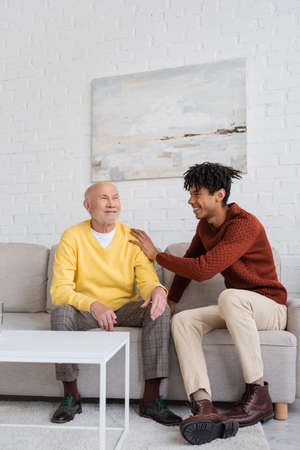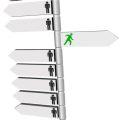Introduction to the Importance of Home Modifications for Seniors
As we age, our needs and abilities change. For many older adults in the United States, the desire to continue living at home—also known as “aging in place”—is strong. However, the typical home may have features that make daily life challenging or even unsafe for seniors. Home modifications can play a crucial role in making sure that seniors can stay independent and safe in their own homes for as long as possible.
Falls are one of the leading causes of injury among older adults, often resulting in hospital stays or long-term care placement. Simple changes in the home environment can greatly reduce these risks. At the same time, making adjustments to the home helps seniors maintain their independence, dignity, and quality of life. These modifications may range from installing grab bars in bathrooms to widening doorways for wheelchair access.
Why Home Modifications Matter
| Benefit | Description |
|---|---|
| Promotes Independence | Enables seniors to perform daily tasks like bathing, cooking, and moving around without constant assistance. |
| Reduces Fall Risk | Modifications such as non-slip flooring and improved lighting lower the chance of slips and falls. |
| Supports Aging in Place | Allows older adults to remain in familiar surroundings rather than moving to assisted living facilities. |
| Enhances Quality of Life | Makes living spaces more comfortable and user-friendly, improving overall well-being. |
Common Challenges Faced by Seniors at Home
- Narrow doorways that limit mobility device access
- Poor lighting leading to trip hazards
- High thresholds or stairs that are difficult to navigate
- Lack of support bars in bathrooms or near entryways
- Kitchens with hard-to-reach cabinets or appliances
The Role of Family and Community
Family members, caregivers, and healthcare professionals all play a role in identifying areas where home modifications can help. Involving everyone ensures that changes made are both practical and supportive of the senior’s lifestyle. Across America, there are also community resources and programs available to assist with funding or implementing these important changes.
2. Assessing the Home Environment: Identifying Risks and Needs
Before making any changes to a senior’s home, it’s important to take a close look at the living space to spot potential hazards and understand specific needs. This step helps families and caregivers create a safer and more comfortable environment that supports independence.
Why Home Assessment Matters
Many accidents involving seniors happen at home, often because of overlooked risks like slippery floors or hard-to-reach items. By evaluating the home environment, you can catch these issues early and make necessary modifications to prevent falls or injuries.
Common Hazards in the Home
| Area | Potential Risks | What to Look For |
|---|---|---|
| Bathrooms | Slippery surfaces, low toilets, hard-to-reach showers | No grab bars, loose rugs, lack of non-slip mats |
| Kitchens | Cluttered countertops, high cabinets, uneven flooring | Cords on floors, heavy pots stored up high |
| Stairs & Hallways | Poor lighting, lack of handrails, trip hazards | No night lights, loose carpets or objects on stairs |
| Living Room/Bedroom | Crowded furniture, loose wires, area rugs | Narrow walkways, cords across walking paths |
The Role of Occupational Therapists and Home Modification Specialists
If you’re unsure where to start, occupational therapists (OTs) or certified home modification specialists can help. These professionals are trained to assess homes from a safety perspective. They consider the individual’s health conditions and daily routines to recommend tailored solutions—for example, installing grab bars in bathrooms or ramps for easier entryways.
How an Assessment Works
- Walkthrough: The OT or specialist will walk through each area of the home with you and your loved one.
- Identify Risks: They’ll point out safety concerns such as poor lighting or obstacles in pathways.
- Understand Needs: They’ll ask about mobility challenges, vision issues, or other health problems that could affect daily life.
- Create a Plan: Based on their findings, they’ll suggest practical changes—like rearranging furniture or adding adaptive equipment—to improve both safety and independence.
Tips for Families and Caregivers
- Check all rooms regularly for new hazards as needs can change over time.
- Involve seniors in the assessment process so their preferences are considered.
- Don’t hesitate to reach out to local agencies or healthcare providers for referrals to specialists.
This careful assessment is a key first step toward creating a home that supports aging in place comfortably and safely.

3. Essential Home Modification Strategies
Key Areas for Senior-Friendly Home Modifications
Making a home safer and more comfortable for seniors means focusing on the most commonly used spaces. The right changes can help prevent falls, boost independence, and make daily routines easier. Let’s look at practical strategies for four key areas: bathrooms, kitchens, entryways, and staircases.
Bathroom Modifications
The bathroom is often the most hazardous room in the house for seniors. Slippery surfaces and tight spaces can lead to accidents, so safety upgrades are essential.
| Modification | Purpose |
|---|---|
| Grab Bars by Toilet & Shower | Provides support when standing or sitting down |
| Non-Slip Mats or Strips | Reduces risk of slipping on wet floors |
| Walk-in Showers or Tubs | Makes bathing easier and safer than stepping over high edges |
| Raised Toilet Seats | Lowers effort required to sit or stand up |
| Handheld Showerheads | Easier control and flexibility while bathing |
Kitchen Modifications
Kitchens should be arranged to minimize reaching, bending, and lifting heavy items. Small changes can make food prep and cleanup much safer.
| Modification | Purpose |
|---|---|
| Pull-out Shelves & Lazy Susans | Makes it easy to reach items in cabinets without stretching or stooping |
| Lever-Style Faucet Handles | Easier to turn on/off with limited grip strength or arthritis |
| Lowered Countertops or Adjustable Workspaces | Makes kitchen tasks more accessible from a seated position or wheelchair |
| Good Lighting Over Work Areas | Helps prevent accidents during meal prep |
| Anti-Fatigue Mats by Sink & Stove | Adds comfort and reduces slip risk while standing for longer periods |
Entryway Modifications
A safe entryway sets the tone for the rest of the home. Steps, thresholds, and poor lighting can all be obstacles. Here are ways to improve accessibility:
- Add sturdy handrails on both sides of steps leading to doors.
- If possible, install a ramp with a gentle slope for wheelchair or walker access.
- Replace door knobs with lever handles for easier use.
- Add motion-sensor lights outside and inside entryways for visibility at night.
- Remove loose rugs or mats that could cause trips at the threshold.
- Create clear pathways free from clutter or obstacles.
Staircase Modifications
Navigating stairs can become challenging with age, but several updates can reduce risks:
- Add secure handrails on both sides of all staircases—make sure they extend beyond the first and last step if possible.
- Add non-slip treads or carpeting to each step to prevent slips.
- Install bright lighting along staircases, including light switches at both ends of the stairs.
- If stairs are still difficult to use, consider installing a stair lift or residential elevator as a long-term solution.
Summary Table: Key Home Modification Strategies by Area
| Area | Main Modifications |
|---|---|
| Bathroom | Grab bars, non-slip mats, walk-in showers/tubs, raised toilet seats, handheld showerheads |
| Kitchen | Pull-out shelves, lever faucets, lowered counters, task lighting, anti-fatigue mats |
| Entryway | Ramps/handrails, lever handles, motion-sensor lighting, clear pathways, no loose rugs/mats |
| Staircase | Duel handrails, non-slip treads/carpeting, improved lighting, stair lifts (if needed) |
Sensible home modifications help seniors feel secure and confident as they move around their homes. By focusing on these key areas and making practical adjustments, you’re taking important steps toward creating a senior-friendly environment that supports safety and independence every day.
4. Funding and Resources for Home Modifications in the U.S.
Making home modifications can help seniors stay safe and independent, but the costs can add up quickly. Luckily, there are several funding options and resources available across the United States to help cover these expenses. Here’s a simple guide to some of the most helpful programs and where you might find additional support.
Medicaid Waivers
Many states offer Medicaid waiver programs that help pay for home modifications if they are medically necessary. These waivers can cover things like wheelchair ramps, grab bars, widened doorways, and bathroom modifications. The rules and coverage vary by state, so it’s important to check with your local Medicaid office or Area Agency on Aging.
Veterans Affairs (VA) Programs
If you or your loved one is a veteran, the U.S. Department of Veterans Affairs offers several programs that provide financial assistance for home adaptations:
- Home Improvements and Structural Alterations (HISA) Grant: Helps veterans make medically necessary changes to their homes.
- Specially Adapted Housing (SAH) Grant: For veterans with certain disabilities to build or modify homes for better accessibility.
- Special Home Adaptation (SHA) Grant: Assists veterans with specific service-connected disabilities to adapt their homes.
Local Government Assistance
Many city and county governments offer grants or low-interest loans for seniors who need to make their homes safer. These programs often have income requirements and may prioritize urgent needs like fall prevention or access improvements. Contact your local housing authority or public health department to ask about available options.
Community Resources
You can also find help from community organizations, nonprofits, and religious groups that focus on senior well-being. Some groups provide free labor or materials for basic modifications like installing handrails or ramps. Others may connect you with volunteers or trusted contractors who offer discounted services.
Quick Overview of Funding Sources
| Resource | Who Qualifies? | What It Covers | Where to Learn More |
|---|---|---|---|
| Medicaid Waivers | Seniors meeting state Medicaid eligibility | Home safety modifications | Your state’s Medicaid office |
| VA Grants (HISA, SAH, SHA) | Eligible veterans with qualifying disabilities | Major home adaptations for accessibility | Department of Veterans Affairs website |
| Local Government Programs | Seniors in participating cities/counties; often income-based | Varies: ramps, grab bars, repairs | City/county housing authority |
| Community Nonprofits & Volunteers | Seniors in need; often low-income priority | Small home safety projects & labor assistance | Local Area Agency on Aging or 211 helpline |
Tips for Getting Started:
- Contact your Area Agency on Aging (AAA): They can guide you to local resources and programs in your community.
- Check eligibility requirements: Each program has its own guidelines—be sure to ask what documentation you’ll need.
- Ask about waitlists: Some funding sources have limited spots, so apply early if possible.
- Look for bundled services: Some agencies offer assessments along with financial aid for modifications.
5. Maintaining Independence: Technology and Ongoing Support
Adaptive Technology for Everyday Living
Technology can make a big difference in the daily lives of seniors. Many adaptive tools are designed to help older adults manage their routines safely and easily at home. Here are some popular options:
| Type of Technology | How It Helps | Examples |
|---|---|---|
| Smart Home Devices | Voice controls for lights, thermostats, and locks reduce the need to move around or reach switches. | Amazon Alexa, Google Home, smart plugs |
| Medication Reminders | Automated alerts help seniors take medications on time and avoid missed doses. | Pill dispensers with alarms, smartphone reminder apps |
| Assistive Phones | Large buttons and clear sound make it easier to communicate with family or caregivers. | Amplified telephones, photo dial phones |
Medical Alert Systems for Safety
Medical alert systems give both seniors and their families peace of mind. These devices allow users to call for help quickly in case of a fall or emergency. Most systems offer wearable buttons or pendants that connect directly to emergency services. Some newer models even include automatic fall detection, GPS location tracking, and two-way communication features so help is always close by—whether at home or on the go.
Connecting with Community Programs
Staying connected to the community is important for maintaining independence and well-being. Many local organizations offer support programs specifically for seniors. These may include:
- Meal Delivery Services: Nutritious meals brought to the home (like Meals on Wheels)
- Transportation Assistance: Rides to medical appointments or grocery stores through senior transit programs
- Friendly Visitor Programs: Volunteers who check in regularly, offering companionship and social interaction
- Home Care Services: Help with household tasks, personal care, or nursing needs provided by trained professionals
Support Networks Matter
Encouraging seniors to use technology alongside community support creates a safer environment and allows them to live more independently. Whether its a simple phone call from a neighbor or using the latest smart device, every bit of support helps seniors stay connected and confident in their own homes.


